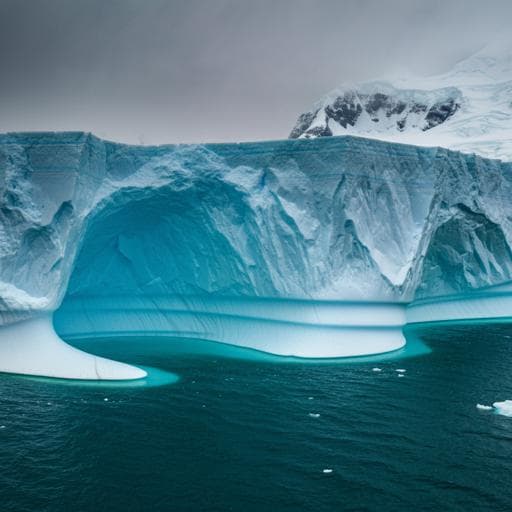
Earth Sciences
Record-high Antarctic Peninsula temperatures and surface melt in February 2022: a compound event with an intense atmospheric river
I. V. Gorodetskaya, C. Durán-alarcón, et al.
In February 2022, the Antarctic Peninsula faced a record-high surface melt and extreme warm event, triggered by an intense atmospheric river and various atmospheric patterns. This alarming event, analyzed by a team of experts including Irina V. Gorodetskaya and Claudio Durán-Alarcón, signals a worrying trend in regional climate patterns likely influenced by global warming, posing risks to ice shelf stability.
~3 min • Beginner • English
Introduction
The study investigates an extreme warm event over the Antarctic Peninsula (AP) in February 2022 against the backdrop of significant global warming and the AP’s pronounced regional warming since the 1950s. The AP has shown increased frequency and intensity of warm extremes with notable temperature records in 2015 and 2020 linked to atmospheric rivers (ARs) and foehn winds. Warm extremes can induce strong cryospheric impacts via albedo feedbacks and surface melt, threatening ice shelf stability. The research aims to detail the 2022 event’s drivers (from local to planetary scales), its thermodynamic and dynamic mechanisms (including ARs, foehn effects, and teleconnections via Rossby waves), and its impacts on temperature, precipitation phase, and surface melt. It also assesses the role of anthropogenic warming using circulation analogs to evaluate amplification and probability changes.
Literature Review
Prior work shows the AP as a hotspot of Southern Hemisphere warming, with stations like Faraday–Vernadsky and Esperanza exhibiting significant long-term warming trends. Extreme AP temperatures in March 2015 and February 2020 were linked to ARs and intensified foehn effects, with teleconnections from enhanced central tropical Pacific convection triggering Rossby wave trains that deepened the Amundsen Sea Low and built strong ridging over the Drake Passage. ARs are recognized as key drivers of Antarctic extremes—both snowfall and surface melt—across regions, and can be enhanced by blocking highs and moisture-laden subtropical sources. Studies also demonstrate the compounding roles of ENSO, SAM, and the Amundsen Sea Low in modulating AP climate. Recent analyses attribute the 2020 heatwave amplification to anthropogenic warming. The literature highlights the vulnerability of AP ice shelves (e.g., Larsen C, George VI, Wilkins) to hydrofracture under increasing surface melt and identifies model challenges in reproducing extremes.
Methodology
The study integrates multi-source observations and modeling:
- Ground observations: Automatic weather stations (AWS) at numerous AP sites provided 2-m air temperatures; radiosondes (GRAW DFM-09, Vaisala RS41) at Escudero and Marambio profiled temperature, humidity, wind, and derived moisture transport and stability parameters (S², N², Richardson number).
- Radar precipitation: An MRR-PRO 24-GHz micro rain radar at Vernadsky measured rainfall profiles, with Ze–R relation (Ze = 200 R^1.6) used to estimate rain rates during 7–8 February 2022.
- Reanalysis: ERA5 (hourly, ~30 km, 137 levels) supplied synoptic fields, integrated vapor transport (IVT), integrated water vapor (IWV), 500-hPa geopotential height, and diagnostics at isentropic levels. AR categorization followed the Ralph et al. AR scale using IVT intensity and duration. ERA5-Land (~9 km) provided snowmelt fields for comparison.
- Regional climate modeling: MAR v3.12 (7.5 km over AP, 1980–2022) with multilayer snow model (30 layers in top 20 m) forced by ERA5 provided surface mass balance components, snowfall, rainfall, and melt amounts/extents. Topography and masks from REMA/BedMachine.
- Mesoscale modeling: Polar WRF v4.3.3 downscaling with nested domains (30/6/1.2 km), advanced P3 microphysics, RRTM radiation, Kain-Fritsch cumulus, and Noah-MP land surface, analyzed local processes (foehn dynamics, radiative/turbulent fluxes).
- Satellite: Passive microwave AMSR-E/AMSR-2 dry/wet snow status (12.5 km) identified melt extent (ascending and descending orbits). Antarctic Satellite Composite imagery aided cloud and moisture visualization.
- Lagrangian analysis: FLEXPART v10.4 (forced by ERA5 at 1°) computed 7–10 day back trajectories for air parcels arriving at Vernadsky at 50 m and 2 km to diagnose moisture sources, boundary layer interactions, and thermodynamic evolution.
- Teleconnection diagnostics: Outgoing longwave radiation (NOAA interpolated OLR) to detect deep convection; Rossby wave source (RWS) and stationary wave fluxes at 200 hPa (Takaya-Nakamura framework) to trace wave propagation; Hovmöller of 500-hPa meridional winds to track wave packets.
- Circulation analogs and extremes: Analog selection based on 500-hPa geopotential over [55°–78°S; 120°–40°W]; reconstruction of synthetic 2-day events for past (1960–1990) vs recent (1991–2021) periods to assess thermodynamic shifts; station-based return periods using Peaks-Over-Threshold and Generalized Pareto Distribution with bootstrap confidence intervals.
Key Findings
- Record and extreme temperatures: On 7–8 February 2022, new absolute maxima were set at King Sejong (13.7 °C), Carlini (13.6 °C), Vernadsky (12.7 °C), and Palmer (11.6 °C). The warm period at King Sejong exceeded the 99th percentile for 32 h; at Vernadsky for 23 h.
- Regional intensity: ERA5 two-day mean temperatures over most of the AP were >5 °C above climatology and above the 99th percentile (1959–2021). Record-breaking two-day 500-hPa geopotential heights occurred over much of the Weddell Sea; IWV reached record values over the Drake Passage, Bellingshausen, and Weddell Seas.
- Precipitation phase and totals: Coastal AP and ice shelves experienced predominantly rainfall; Palmer and Ellsworth Lands received snowfall. MAR estimated AP-mean daily rainfall peaking at ~18 mm w.e., the highest February daily value since 1980. Vernadsky recorded ~10 mm/day rainfall, while nearby windward slopes exceeded 80 mm/day (Polar WRF), highlighting strong orographic contrasts.
- Surface melt: Widespread melt on both AP flanks; AP-mean daily accumulated melt peaked at 6.2 Gt on 8 Feb. Melt extent reached record highs since 1980–2003 depending on dataset: satellite observed 257,741 km² (52% of AP) with MAR indicating 73%. Entire Larsen C experienced melt; MAR showed >80 mm w.e. accumulated over 6–9 Feb in parts of Larsen C, George VI, and Wilkins.
- Atmospheric river characteristics: The AR made landfall in Chile as Category 5 (IVT >1000 kg m−1 s−1) and later impacted the AP as Category 3 (IVT up to 600–650 kg m−1 s−1). Exceptional IWV persisted over the Weddell Sea (daily means >22 mm on 8–9 Feb), marking the highest on record since 1979 for that region.
- Vertical structure and fluxes: Radiosondes at King George Island showed a warm, moist, and windy layer with maxima around 900–950 hPa (temperature ~13 °C, specific humidity ~8 g kg−1, winds ~25 m s−1), with temperatures >0 °C up to 700 hPa. High-resolution Polar WRF diagnosed: upwind LW cloud warming; leeside foehn with strong sensible heat fluxes (up to ~300 W m−2) driving nighttime warming; enhanced daytime net shortwave under foehn-induced cloud clearance.
- Large-scale drivers: A deep Amundsen Sea cyclone and a record ridge over the Drake Passage/Weddell Sea steered a meridional AR toward the AP. Persistent tropical convection over the western/central Pacific and SPCZ during La Niña generated positive RWS and stationary wave fluxes, promoting Rossby wave propagation, secondary Amundsen Low development, and ridge amplification into the Weddell Sea. Rossby wave breaking (cyclonic/anticyclonic) framed AR evolution (5–9 Feb).
- Moisture sources: Enhanced subtropical-to-midlatitude evaporation anomalies over warm SSTs fed the AR. FLEXPART back-trajectories show air parcels gained moisture in the subtropical southeast Pacific (1–5 Feb) before rapid approach to South America/AP and moisture loss via precipitation.
- Extremes context: Analog-based attribution indicates recent-period (1991–2021) temperatures are ~0.4 °C warmer regionally; the 2-day anomaly distribution is ~0.2 °C warmer than the past (1960–1990). The probability of reaching a 3.0 °C 2-day anomaly increased from the 99.8th percentile (past) to the 96.3rd percentile (recent), implying thermodynamic amplification by global warming. Station return periods: Vernadsky’s 6-h max (11.9 °C) corresponds to ~116-year local RP (about 40-year RP at AP regional scale); Rothera ~1.4 years; others <1 year.
- Operational impacts and UTLS conditions: The event caused aviation and maritime disruptions due to winds and low clouds. Radiosondes indicated elevated/cold tropopauses (~12 km), strong shear and stability structures consistent with tropopause folds, and conditions favorable for clear-air turbulence over the Drake Passage.
Discussion
The February 2022 Antarctic Peninsula hot spell was a multivariate and spatial compound event featuring concurrent extremes in temperature, moisture (IWV/IVT), pressure, rainfall, and surface melt over a broad area, with simultaneous impacts in southern South America. The event resulted from the interaction of synoptic AR dynamics with planetary-scale circulation: tropical convection over the SPCZ during La Niña initiated Rossby wave activity that deepened the Amundsen Sea Low and intensified a ridge over the Drake Passage/Weddell Sea, directing a meridional AR toward the AP. Locally, AR-induced cloud LW warming and foehn-driven turbulent fluxes (sensible and latent) enhanced nighttime warming, while daytime cloud clearance increased net shortwave on the leeside, sustaining melt. Compared to the 2015 and 2020 events, the 2022 AR had a more meridional orientation and produced less leeside foehn warming at the far northeastern AP but broader melt across both sides, with particularly strong melt in northern Larsen C and coastal Palmer Land/George VI. Circulation analogs demonstrate that while dynamical circulation analogs were similar between past and recent periods, background warming has shifted temperature distributions, increasing the likelihood and intensity of such compound hot spells. The observed extremes, including record IWV in the Weddell Sea and widespread rainfall on ice shelves, underscore heightened risks to ice-shelf stability through enhanced surface melt and potential hydrofracture. Operationally, the event revealed forecasting challenges and risks to aviation from UTLS turbulence. Together, findings connect tropical variability, midlatitude wave dynamics, ARs, and local foehn processes as key components in AP extreme warmth and melt.
Conclusion
The study documents a February 2022 compound hot spell over the Antarctic Peninsula that produced record or near-record temperatures, exceptional rainfall, and unprecedented short-period melt extent and magnitude. An intense atmospheric river, steered by an Amundsen Sea Low–Weddell Sea ridge couplet linked to tropical convection and Rossby wave activity, combined with foehn processes and radiative effects to drive widespread melt across remaining AP ice shelves. Circulation analogs indicate that anthropogenic warming likely amplified the event and increased its probability. Given projections of increasing AP temperatures and warm-event frequency and duration, such AR-driven compound events will become more consequential for ice shelf stability and regional ecosystems. Future work should refine process-level understanding of thermodynamic versus dynamical contributions, improve model representation of extremes (from global to regional scales), enhance forecasting tools for ARs/foehn/cloud–radiation interactions, and assess cascading impacts on sea-ice, ice-shelf hydrofracture risk, and operations.
Limitations
- Model and data uncertainties: ERA5-Land underestimates melt extent relative to satellite and MAR; MAR can overestimate peak melt at some sites (e.g., due to elevation differences). CMIP-class climate models struggle with the statistics of extremes, limiting direct projection reliability for hot spells.
- Attribution scope: The circulation analog approach isolates thermodynamic warming effects but does not quantify possible changes in circulation dynamics; thus, dynamical contributions remain uncertain.
- Spatial resolution and representativeness: Complex AP topography induces strong small-scale precipitation and foehn variability that challenges even 1.2-km modeling; localized observations (e.g., Vernadsky radar) may not capture full spatial gradients.
- Event classification and records: Station return periods vary widely; regional aggregation reduces RP, indicating that local record-setting may not represent basin-wide extremity.
- Limited temporal sampling of radiosondes and satellite overpasses may miss subdaily variability in moisture/fluxes and turbulence diagnostics.
Related Publications
Explore these studies to deepen your understanding of the subject.







